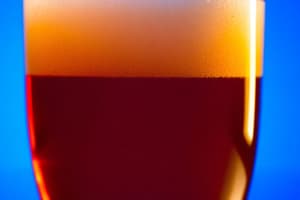Podcast
Questions and Answers
What does the Lambert-Beer law state about absorbance?
What does the Lambert-Beer law state about absorbance?
- Absorbance is directly proportional to both sample path length and concentration. (correct)
- Absorbance remains constant regardless of changes in concentration.
- Absorbance is independent of sample concentration.
- Absorbance is inversely proportional to sample path length.
Which type of spectrophotometer measures absorbance in the range of 200 nm to 700 nm?
Which type of spectrophotometer measures absorbance in the range of 200 nm to 700 nm?
- UV-Vis Spectrophotometer (correct)
- Infrared Spectrophotometer
- Fluorescence Spectrophotometer
- NMR Spectrophotometer
What is the role of filters in colorimeters?
What is the role of filters in colorimeters?
- To increase the amount of light transmitted regardless of concentration.
- To allow the maximal absorption wavelengths to pass and improve sensitivity. (correct)
- To absorb all wavelengths of light uniformly.
- To completely block the targeted wavelengths from entering the solution.
Which of the following is NOT an application of spectrophotometers?
Which of the following is NOT an application of spectrophotometers?
In what way does the use of cuvettes affect spectrophotometric measurements?
In what way does the use of cuvettes affect spectrophotometric measurements?
What is one of the main differences between UV-Vis and IR spectrophotometers?
What is one of the main differences between UV-Vis and IR spectrophotometers?
Which statement correctly describes the application of spectrophotometry in hospitals?
Which statement correctly describes the application of spectrophotometry in hospitals?
What does the term 'structure elucidation of organic compounds' refer to in the context of spectrophotometry?
What does the term 'structure elucidation of organic compounds' refer to in the context of spectrophotometry?
What is the primary function of spectrophotometry?
What is the primary function of spectrophotometry?
Why does chlorophyll make plants appear green?
Why does chlorophyll make plants appear green?
What does an absorption spectrum represent?
What does an absorption spectrum represent?
What is a standard curve used for in spectrophotometry?
What is a standard curve used for in spectrophotometry?
What does the Lambert-Beer Law describe?
What does the Lambert-Beer Law describe?
Which property of substances can affect how much light they absorb, despite having similar wavelengths?
Which property of substances can affect how much light they absorb, despite having similar wavelengths?
What is colorimetry an alternative term for?
What is colorimetry an alternative term for?
In what scenario would one ideally use a standard curve?
In what scenario would one ideally use a standard curve?
Flashcards are hidden until you start studying
Study Notes
Introduction to Spectrophotometry
- Substances absorb specific light wavelengths due to their molecular structure. Chlorophyll, for example, absorbs red light but transmits green, resulting in its green appearance.
- While two substances may absorb the same wavelengths, the degree of absorption differs due to variations in molecular structure.
- Spectrophotometry quantitatively measures a solution's light absorption and transmission. If the solution is colored, it's called colorimetry.
Absorption Spectrum
- An absorption spectrum is a graph showing a substance's light absorbance at different wavelengths. Riboflavin's absorption spectrum is given as an example (Figure 23 – not shown here).
Standard Curve
- A standard curve graphs light absorption against known concentrations of a substance. It helps determine unknown concentrations by interpolating absorbance values. The Lambert-Beer Law offers a more precise method for concentration determination.
Lambert-Beer Law
- The Lambert-Beer Law describes the direct proportionality between absorbance and the sample's path length and concentration.
- It has broad applications in various fields, including medicine and organic chemistry.
Spectrophotometer
- A spectrophotometer measures light absorption or transmission in a solution.
- Some colorimeters use filters instead of monochromators and selectors to maximize sensitivity by focusing on wavelengths maximally absorbed by the solution.
- Spectrophotometers are categorized by light source wavelength.
- UV-Vis spectrophotometers measure absorbance in the ultraviolet (200-700 nm) and visible range.
- IR spectrophotometers utilize infrared light (700-15000 nm).
Spectrophotometer Applications
- Determining substance concentrations
- Detecting impurities
- Elucidating the structure of organic compounds
- Monitoring dissolved oxygen in aquatic ecosystems
- Characterizing proteins
- Identifying functional groups
- Analyzing respiratory gases in hospitals
- Determining molecular weight of compounds
- Identifying compound classes in pure and biological samples.
Studying That Suits You
Use AI to generate personalized quizzes and flashcards to suit your learning preferences.




